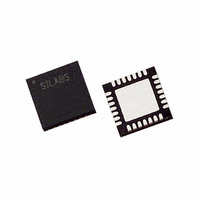C8051F321-GM Silicon Laboratories Inc, C8051F321-GM Datasheet - Page 204

C8051F321-GM
Manufacturer Part Number
C8051F321-GM
Description
IC 8051 MCU 16K FLASH 28MLP
Manufacturer
Silicon Laboratories Inc
Series
C8051F32xr
Datasheets
1.C8051F320-TB.pdf
(250 pages)
2.C8051F321-GMR.pdf
(2 pages)
3.C8051F321-GM.pdf
(256 pages)
Specifications of C8051F321-GM
Program Memory Type
FLASH
Program Memory Size
16KB (16K x 8)
Package / Case
28-VQFN Exposed Pad, 28-HVQFN, 28-SQFN, 28-DHVQFN
Core Processor
8051
Core Size
8-Bit
Speed
25MHz
Connectivity
SMBus (2-Wire/I²C), SPI, UART/USART, USB
Peripherals
Brown-out Detect/Reset, POR, PWM, Temp Sensor, WDT
Number Of I /o
21
Ram Size
2.25K x 8
Voltage - Supply (vcc/vdd)
2.7 V ~ 3.6 V
Data Converters
A/D 13x10b
Oscillator Type
Internal
Operating Temperature
-40°C ~ 85°C
Processor Series
C8051F3x
Core
8051
Data Bus Width
8 bit
Data Ram Size
2.25 KB
Interface Type
I2C/SMBus/SPI/UART/USB
Maximum Clock Frequency
25 MHz
Number Of Programmable I/os
21
Number Of Timers
4
Operating Supply Voltage
2.7 V to 3.6 V
Maximum Operating Temperature
+ 85 C
Mounting Style
SMD/SMT
3rd Party Development Tools
PK51, CA51, A51, ULINK2
Development Tools By Supplier
C8051F320DK
Minimum Operating Temperature
- 40 C
On-chip Adc
13-ch x 10-bit or 17-ch x 10-bit
No. Of I/o's
21
Ram Memory Size
1280Byte
Cpu Speed
25MHz
No. Of Timers
4
Rohs Compliant
Yes
Lead Free Status / RoHS Status
Lead free / RoHS Compliant
For Use With
336-1480 - DAUGHTER CARD TOOLSTCK C8051F321770-1006 - ISP 4PORT FOR SILABS C8051F MCU336-1449 - ADAPTER PROGRAM TOOLSTICK F321336-1260 - DEV KIT FOR C8051F320/F321
Eeprom Size
-
Lead Free Status / Rohs Status
Lead free / RoHS Compliant
Other names
336-1261
Available stocks
Company
Part Number
Manufacturer
Quantity
Price
Company:
Part Number:
C8051F321-GM
Manufacturer:
SiliconL
Quantity:
4 364
Part Number:
C8051F321-GM
Manufacturer:
SILICON LABS/芯科
Quantity:
20 000
Part Number:
C8051F321-GMR
Manufacturer:
SILICON LABS/芯科
Quantity:
20 000
C8051F320/1
18.1. Signal Descriptions
The four signals used by SPI0 (MOSI, MISO, SCK, NSS) are described below.
18.1.1. Master Out, Slave In (MOSI)
The master-out, slave-in (MOSI) signal is an output from a master device and an input to slave devices. It is used to
serially transfer data from the master to the slave. This signal is an output when SPI0 is operating as a master and an
input when SPI0 is operating as a slave. Data is transferred most-significant bit first. When configured as a master,
MOSI is driven by the MSB of the shift register in both 3- and 4-wire mode.
18.1.2. Master In, Slave Out (MISO)
The master-in, slave-out (MISO) signal is an output from a slave device and an input to the master device. It is used
to serially transfer data from the slave to the master. This signal is an input when SPI0 is operating as a master and an
output when SPI0 is operating as a slave. Data is transferred most-significant bit first. The MISO pin is placed in a
high-impedance state when the SPI module is disabled and when the SPI operates in 4-wire mode as a slave that is
not selected. When acting as a slave in 3-wire mode, MISO is always driven by the MSB of the shift register.
18.1.3. Serial Clock (SCK)
The serial clock (SCK) signal is an output from the master device and an input to slave devices. It is used to synchro-
nize the transfer of data between the master and slave on the MOSI and MISO lines. SPI0 generates this signal when
operating as a master. The SCK signal is ignored by a SPI slave when the slave is not selected (NSS = 1) in 4-wire
slave mode.
18.1.4. Slave Select (NSS)
The function of the slave-select (NSS) signal is dependent on the setting of the NSSMD1 and NSSMD0 bits in the
SPI0CN register. There are three possible modes that can be selected with these bits:
See Figure 18.2, Figure 18.3, and Figure 18.4 for typical connection diagrams of the various operational modes. Note
that the setting of NSSMD bits affects the pinout of the device. When in 3-wire master or 3-wire slave mode, the
NSS pin will not be mapped by the crossbar. In all other modes, the NSS signal will be mapped to a pin on the device.
See Section
204
1.
disabled. When operating as a slave device, SPI0 is always selected in 3-wire mode. Since no select signal is
present, SPI0 must be the only slave on the bus in 3-wire mode. This is intended for point-to-point commu-
nication between a master and one slave.
2.
enabled as an input. When operating as a slave, NSS selects the SPI0 device. When operating as a master, a
1-to-0 transition of the NSS signal disables the master function of SPI0 so that multiple master devices can
be used on the same SPI bus.
3.
put. The setting of NSSMD0 determines what logic level the NSS pin will output. This configuration should
only be used when operating SPI0 as a master device.
“14. Port
NSSMD[1:0] = 00: 3-Wire Master or 3-Wire Slave Mode: SPI0 operates in 3-wire mode, and NSS is
NSSMD[1:0] = 01: 4-Wire Slave or Multi-Master Mode: SPI0 operates in 4-wire mode, and NSS is
NSSMD[1:0] = 1x: 4-Wire Master Mode: SPI0 operates in 4-wire mode, and NSS is enabled as an out-
Input/Output” on page
127
for general purpose port I/O and crossbar information.
Rev. 1.1











